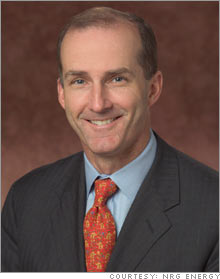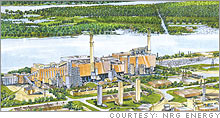Cleaning up coal's bad rapTo critics, 'clean coal' is an oxymoron. To NRG Energy CEO David Crane, it's the future. Fortune's Marc Gunther reports.(Fortune Magazine) -- Is coal becoming a dirty word? It's vilified as a contributor to global warming, risky to get out of the earth -- as recent deaths in a Utah coal mine have reminded us -- and responsible for destroying streams and valleys in Appalachia, where mountaintop removal mining remains extremely controversial. Meanwhile, pressure from environmental groups worried about climate change has forced utilities from North Carolina to Oregon to drop plans for about two dozen coal-fired power plants.
So what's the CEO of a coal-burning utility to do? David Crane, the chief executive of NRG Energy (Charts, Fortune 500), a New Jersey-based wholesale power generator that produces electricity for other utilities, has some ideas. About 70% of the company's electricity is currently generated by burning coal. Crane is pushing an array of alternative energy projects. He's looking to build two nuclear energy plants in Texas. He's developing wind farms in Texas and California. He's even testing technology that uses algae to capture carbon dioxide emissions at fossil-fuel plants, after which the algae can be dried and turned into a fuel itself. Crane calls the need to curb climate change a "moral issue." NRG belongs to the U.S. Climate Partnership, an alliance of big companies and environmental groups that supports strong federal regulation to regulate carbon emissions. Yet, for all his focus on renewable energy, Crane remains a big believer in coal. Indeed, he's become one of the power industry's leading advocates of "clean coal," an industry term for new power-producing processes that reduce carbon dioxide emissions. While critics say "clean coal" is an oxymoron, Crane argues that it's a promising solution to the problem of climate change. "If you really want to move the needle on global warming," Crane says, "nuclear [power] is important -- but the key is clean coal." NRG plans to develop about $16 billion worth of what it calls "environmentally responsible" power plants over the next decade. As part of that agenda, the company is seeking state and federal approval, and subsidies, for a 680-megawatt plant in upstate New York that would be the first big coal plant in America to capture and store carbon dioxide. The proposed plant, to be located in Tonawanda, N.Y. represents a $1.5 billion bet that clean coal can become a reality. The plant would use two existing technologies. One is called Integrated Gasification Combined Cycle, or IGCC, which turns coal into a gas, cleans the gas to remove emissions and burns it in an efficient way. The other is Carbon Capture and Storage, or CCS, which captures CO2 emissions, transports them if needed, and stores them as a liquid in underground formations. Both technologies have been commercially deployed, but never in combination at the scale that NRG proposes. Crane is confident that the technologies will work, but he admits that the plant raises a thicket of legal and economic issues, particularly around the issue of long-term carbon storage. "It's a political, commercial and regulatory challenge," he says. "Who actually owns the carbon? Where's the liability?" NRG does not want to be responsible for the stored carbon, arguing that the alternative -- releasing CO2 into the air -- is worse than asking the government to take responsibility for carbon in the earth. The other big challenge is cost. Building an IGCC plant will probably cost about 20% more than building a conventional coal plant, Crane says, and the costs of capturing and sequestering carbon could add another 20 to 25%. What do environmentalists think of clean coal? They disagree, it turns out. The Natural Resources Defense Council and Environmental Defense, which work closely with big companies like General Electric (Charts, Fortune 500) that are promoting clean coal, support the idea. Coal-burning currently generates more than 50% of the electricity in the United States, they note, and it is an abundant, domestic fuel. Environmental Defense's Steve Cochran, who leads the group's climate change campaign, recently told me: "My son's 11 years old -- his kids will be turning on light switches that come from coal-fired plants." By contrast, Mike Brune of the activist Rainforest Action Network, describes clean coal as a "huge boondoggle" that will eliminate the cost advantages currently enjoyed by coal. The coal industry, he argues, "is desperately trying to remain relevant in a post-carbon world." David Roberts of Grist, a popular website that covers the environment, is even more blunt. "Can you imagine another industry that destroys land in order to sell a product that poisons people and threatens to make the earth uninhabitable not only being allowed to operate, but having its continued profit taken as a kind of national imperative?" he writes. "It's bizarre." Crane isn't swayed by critics, and suggests they're overlooking a harsh reality. "Even if the United States could wean itself from coal, China and India are not going to," he says. "We need to develop the technology to use coal in a cleaner way." |
Sponsors
| |||||||||||||||


